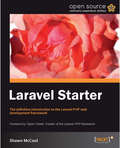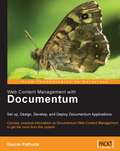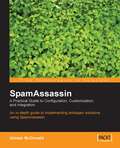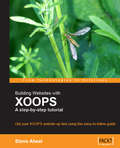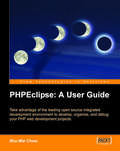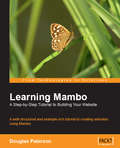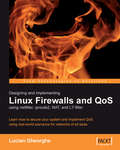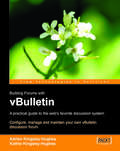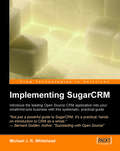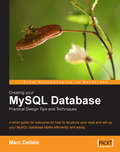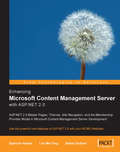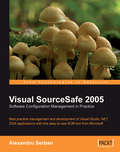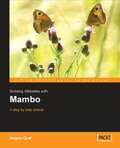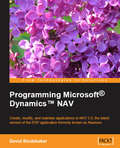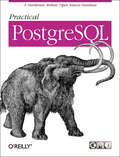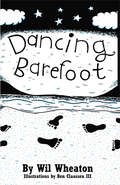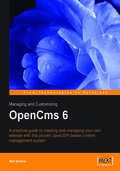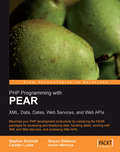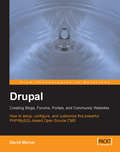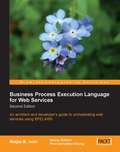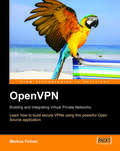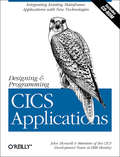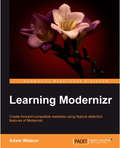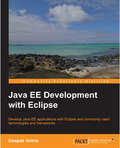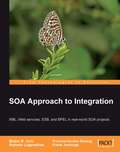- Table View
- List View
Laravel Starter
by Shawn MccoolThis book is a practical, task-based, step-by-step tutorial that demonstrates topics ranging from MVC code-separation, to code-modularity, to utilizing ActiveRecord for data abstraction which are explained from the ground-up to provide a strong framework of understanding for creating professional web-applications with Laravel. This book is ideal for programmers familiar with PHP who are interested in learning the Laravel way of solving the common problems faced in their day to day work.
Web Content Management with Documentum
by Gaurav KathuriaConcise information about the various Documentum web content management products, and packed with practical examples. This book is targeted at IT professionals who are Documentum beginners or intermediates. The depth of coverage means that experienced Documentum developers will also benefit from the book, and learn some new tricks. Although no knowledge of Documentum is presumed, exposure to Java/J2EE, XML, and related web technologies will help to get the most from this book.
SpamAssassin: A practical guide to integration and configuration
by Alistair McdonaldWritten specifically for busy network and system administrators, the book is a detailed and practical guide to implementing the right antispam solution for your network and your business requirements. You'll go from a detailed walk through of initial set up, to advanced configuration options like Bayesian filtering, listing, rewriting, and rules. The book shows how to optimize SpamAssassin for all major mail servers and clients. If you are a network or system administrator and you're either using or evaluating SpamAssassin, this book will increase your understanding and transform your productivity.
Building Websites with XOOPS: A step-by-step tutorial
by Steve AtwalWritten in a clear, easy to read style, the book takes you through the essential tasks required to create a XOOPS website as quickly as possible. Each task is tackled in a clear and practical way. This book is suitable for web developers, designers, webmasters, and marketing professionals who want develop a fully featured web presence in a simple and straightforward process using XOOPS. It does not require any detailed knowledge of programming or web development, and any IT confident individual will be able to use the book to produce an impressive web site.
PHPEclipse: A User Guide
by Shu-Wai ChowWritten in a concise and friendly style, packed with tips and a practical project, this book will instruct you on using PHPEclipse to make your PHP application development more efficient, and cut development time. This book is written for PHP developers who want an open source development environment for creating web applications. You do not need any knowledge of Java or prior experience of Eclipse to use this book.
Learning Mambo: A Step-by-Step Tutorial to Building Your Website
by Douglas PatersonWritten in a clear, easy-to-read style, the book provides a tutorial for setting up a Mambo website. Each topic is tackled in a practical way with many examples and tasks to develop your skills. A realistic example website is developed incrementally through the book, showing each step in detail. This book is suitable for web developers, designers, webmasters, content editors, and marketing professionals who want develop a fully featured web presence in a simple and straightforward process. No prior knowledge of Mambo is expected, and it does not require any detailed knowledge of programming or web development. Any IT-confident individual will be able to use the book to produce an impressive website.
Designing and Implementing Linux Firewalls and QoS using netfilter, iproute2, NAT and l7-filter
by Lucian GheorgheThe author draws on his experience to offer the reader valuable advice on the best practices. Providing only necessary theoretical background, the book takes a practical approach, presenting case studies and plenty of illustrative examples. This book is aimed at Linux Network administrators with some understanding of Linux security threats and issues, or any one interested in securing their systems behind a firewall. Basic knowledge of Linux is presumed but other than that this book shows you how to do the rest, from configuring your system to dealing with security breaches.
vBulletin: A Users Guide
by Kathy Kingsley-Hughes Adrian Kingsley-HughesUsing a highly graphical, practical style the experienced authors show you how to get the most out of vBulletin. This book is written for new and intermediate users of vBulletin, who want to manage and maintain a vBulletin discussion forum as easily as possible. No experience of web programming is required.
Implementing SugarCRM
by Michael J.R. WhiteheadUsing a unique checklist approach the book works from the SugarCRM basics right up to advanced features in a clear, friendly way. It is carefully designed to distil hard-won SugarCRM wisdom from a recognized expert into a clear, readable, practical guide. By helping you clarify your business goals the book enables you to build a CRM system to support your business needs, and shows SugarCRM in a realistic business setting through an Extended case study. Small-medium business owners/managers with reasonable IT skills, who want to implement SugarCRM for themselves as either a first CRM or as a replacement for existing solutions. IT staff tasked with implementing, maintaining, or upgrading a SugarCRM installation Existing SugarCRM users who want to broaden their understanding of the topic No programming knowledge is required to use this book to implement, customise and use SugarCRM
Creating your MySQL Database: Practical Design Tips and Techniques
by Marc DelisleThis book takes a practical approach, implementing all theoretical concepts with examples. It is a fast-paced tutorial that focuses on critical decisions that you need to make every time you build MySQL databases. It is rich with tips and advice from an experienced practitioner. Anyone working with applications that use a MySQL database backend will benefit greatly from the advice and techniques in this book. Although a working knowledge of both SQL and MySQL is assumed, the book is suitable for both beginners and intermediate users alike. Whether you read it through and absorb the advice or work through it on a live project, the efficiency and maintainability of your databases will certainly improve as a result.
Enhancing Microsoft Content Management Server with ASP.NET 2.0
by Lim Mei YingThe book is written for developers who work with Microsoft Content Management Server, and want to update their skills to take advantage of the latest offerings in ASP.NET. If you are an MCMS developer who hasn't yet got into ASP.NET 2.0, this book is an ideal introduction to the most exciting features of ASP.NET 2.0, and how you can make them work for you.
Visual SourceSafe 2005 Software Configuration Management in Practice
by Aleksandar SeovicAfter introducing the fundamental principles of SCM and the benefits of using SCM to manage the software development lifecycle this book uses a real-world case-study project to build a Service-Oriented Application named Orbital Hotel. You will learn the team cooperation features in Visual SourceSafe with the help of John and Mary, two fictional team members assigned to implement various project components. You can visit Orbital Hotel online and you can download its source code. The appendices deal with SourceSafe administration tasks: database creation and management, how to secure the database and how to assign users and user rights, how to manage projects and project settings, and how to customize SourceSafe to best suit your development style. This book is for .NET developers, testers and configuration managers who: Use Visual Studio .NET 2005 for building software Want to use software configuration to manage their products in day-to-day activities Want to improve their efficiency by learning to use the best practices with SourceSafe Want to install, manage, and configure Visual SourceSafe 2005 for optimal operation The book does not assume previous knowledge of Software Configuration Management or Visual SourceSafe. It takes the reader from the ground up and is a great resource for people starting to learn about this subject. Readers with previous SourceSafe experience will benefit by discovering the improved and new features in Visual SourceSafe 2005.
Building Websites with Mambo
by Hagen GrafThis book focuses on taking you through the essential tasks to create a Mambo site as fast as possible. These essential tasks are explained clearly, with well structured step by step instructions. The book does not aim to cover every feature of Mambo, nor is it a comprehensive guide to extending Mambo. Almost everything in the book is accomplished without recourse to the underlying PHP code in which Mambo is written. The book is very readable and the author has a particularly chatty and engaging writing style. This book is suitable for web developers, designers, webmasters, content editors and marketing professionals who want develop a fully featured web presence in a simple and straightforward process. It does not require any detailed knowledge of programming or web development, and any IT confident individual will be able to use the book to produce an impressive web site.
Programming Microsoft® Dynamics™ NAV
by David StudebakerFast-paced and to-the-point, this book takes you through the important topics of Microsoft Dynamics NAV with clear explanations and practical example code. The book's selection of topics is driven by what the working developer needs to know in order to become productive as quickly as possible. The business applications software designer/developer who: Wants to become productive in NAV C/SIDE C/AL development as quickly as possible Understands business applications and the associated software Has significant programming experience Has access to NAV including at least the Designer granules, preferably a full development license and a standard Cronus demo database Is willing to do the exercises to get hands-on experience The Reseller manager or executive who wants a concise, in depth view of NAVs development environment and tool set The technically knowledgeable manager or executive of a firm using NAV that is about to embark on a significant NAV enhancement project The technically knowledgeable manager or executive of a firm considering purchase of NAV as a highly customizable business applications platform The reader of this book: Does not need to be expert in object-oriented programming Does not need to have previous experience with NAV
Practical PostgreSQL
by Joshua D. Drake John C. WorsleyArguably the most capable of all the open source databases, PostgreSQL is an object-relational database management system first developed in 1977 by the University of California at Berkeley. In spite of its long history, this robust database suffers from a lack of easy-to-use documentation. Practical PostgreSQL fills that void with a fast-paced guide to installation, configuration, and usage. This comprehensive new volume shows you how to compile PostgreSQL from source, create a database, and configure PostgreSQL to accept client-server connections. It also covers the many advanced features, such as transactions, versioning, replication, and referential integrity that enable developers and DBAs to use PostgreSQL for serious business applications. The thorough introduction to PostgreSQL's PL/pgSQL programming language explains how you can use this very useful but under-documented feature to develop stored procedures and triggers. The book includes a complete command reference, and database administrators will appreciate the chapters on user management, database maintenance, and backup & recovery. With Practical PostgreSQL, you will discover quickly why this open source database is such a great open source alternative to proprietary products from Oracle, IBM, and Microsoft. Also included is a CD-ROM with Command Prompt's PostgreSQL Application Server, LXP. The CD covers LXP version 0.8.0 and PostgreSQL version 7.1.3.
Dancing Barefoot
by Wil WheatonWil Wheaton--blogger, geek, and Star Trek: The Next Generation's Wesley Crusher--gives us five short-but-true tales of life in the so-called Space Age in Dancing Barefoot. With a true geek's unflinching honesty, Wil examines life, love, the web, and the absurdities of Hollywood in these compelling autobiographical narratives. Based on pieces first published in Wil's hugely popular blog, www.wilwheaton.net, the stories in Dancing Barefoot chronicle a teen TV star's journey to maturity and self-acceptance. Far from the usual celebrity tell-all, Dancing Barefoot is a vivid account of one man's version of that universal story, the search for self. If you've ever fallen in love, wondered what goes on behind the scenes at a Star Trek convention, or thought hard about the meaning of life, you'll find a kindred soul in the pages of Dancing Barefoot. In the process of uncovering his true geeky self, Wil Wheaton speaks to the inner geek in all of us. The stories: Houses in Motion - Memories fill the emptiness left within a childhood home, and saying goodbye brings them to life. Ready Or Not Here I Come - A game of hide-n-seek with the kids works as a time machine, taking Wil on a tour of the hiding and seeking of years gone by. Inferno - Two 15-year-olds pass in the night leaving behind pleasant memories and a perfumed Car Wars Deluxe Edition Box Set. We Close Our Eyes - A few beautiful moments spent dancing in the rain. The Saga of SpongeBob VegasPants - A story of love, hate, laughter and the acceptance of all things Trek.
Managing and Customizing OpenCms 6 Websites
by Matt ButcherWritten in an accessible and easy to read style, this book is packed with practical advice to help you create your OpenCMS website. This book is for anyone who wants to get an OpenCMS website up and running as quickly as possible, whether you are a user, administrator, designer or webmaster. You do not have to be a Java developer to benefit from this book, although a working knowledge of Java, JSP, and XML will help you to get the most from OpenCMS, and this book.
PHP Programming with PEAR
by Stoyan Stefanov Carsten LuckePacked with code examples, every topic is explained in a clear, practical way. This book is for PHP developers who want to maximize their productivity through the use of proven, high-quality, reusable PEAR components. Some experience of working with PEAR classes will prove helpful, and developers who've used PEAR before can find something new to delight them.
Drupal: Creating Blogs, Forums, Portals, and Community Websites
by David MercerThis book will suit anyone who has a need to create a content rich website. Whether you are: Adding a personal web page Building a forum Writing a collaborative book Retailing goods Creating a blog Launching a community Website This book will prove to be an indispensable companion. Both experts and beginners to computing alike will find the information contained herein to be accessible and easy to intuit.
Business Process Execution Language for Web Services Second Edition
by Benny MathewThis book is aimed at architects and developers in the design, implementation, and integration phases of advanced information systems and e-business solutions, developing business processes and dealing with the issues of composition, orchestration, transactions, coordination, and security. The book presumes knowledge of XML and web services, web services development (either on J2EE or .NET), and multi-tier architecture
OpenVPN: Building and Integrating Virtual Private Networks
by Markus FeilnerNetwork administrators and any one who is interested in building secure VPNs using OpenVPN. It presumes basic knowledge of Linux, but no knowledge of VPNs is required. All basic VPN and relevant security concepts are covered.
Designing and Programming CICS Applications
by John Horswill Members of the CICS Development Team at IBM HursleyCICS is an application server that delivers industrial-strength, online transaction management for critical enterprise applications. Proven in the market for over 30 years with many of the world's leading businesses, CICS enables today's customers to modernize and extend their applications to take advantage of the opportunities provided by e-business while maximizing the benefits of their existing investments. Designing and Programming CICS Applications will benefit a diverse audience. It introduces new users of IBM's mainframe (OS/390) to CICS features. It shows experienced users how to integrate existing mainframe systems with newer technologies, including the Web, CORBA, Java, CICS clients, and Visual Basic; as well as how to link MQSeries and CICS. Each part of Designing and Programming CICS Applications addresses the design requirements for specific components and gives a step-by-step approach to developing a simple application. The book reviews the basic concepts of a business application and the way CICS meets these requirements. It then covers a wide range of application development technologies, including VisualAge for Java, WebSphere Studio, and Visual Basic. Users learn not only how to design and write their programs but also how to deploy their applications. Designing and Programming CICS Applications shows how to: Develop and modify existing COBOL applications Become familiar with the CICS Java environment and write a simple Java wrapper for a COBOL application Develop a web front end using servlets, JSP and JavaBeans. Link the web front end to an existing COBOL application using CORBA Write a Visual Basic application to develop a customer GUI Link an existing COBOL application using a CICS Client ECI call Develop a Java application using Swing as an MQSeries Client Use the MQSeries-CICS bridge to access an existing COBOL application Whether for working with thousands of terminals or for a client/server environment with workstations and LANs exploiting modern technology such as graphical interfaces or multimedia, Designing and Programming CICS Applications delivers the power to create, modernize and extend CICS applications.
Learning Modernizr
by Adam WatsonWritten in an engaging, easy-to-follow style, "Learning HTML5 Modernizr" is a practical guide for using the feature detection features of HTML5 Modernizr to create forward compatible sites. "Learning HTML5 Modernizr" is great for developers looking for a broad range of use cases for feature detection. It is particularly meant for web developers who want to take advantage of the cool new HTML5 and CSS5 features but at the same time deliver a design that is not only backward, but forward compatible.
Java EE Development with Eclipse
by Deepak VohraThis book is step-by-step tutorial guide and a background reference for developing applications with Oracle WebLogic Server and Oracle database, the most used application server and database for enterprise applications. This book is for professional Java EE developers. The book is also suitable for an intermediate/advanced course in Java development with Eclipse IDE. Some knowledge of the Java EE technologies and frameworks EJB, JSF, JAXB, JAX-WS, JAX-RS, Ajax, and Spring is required.
SOA Approach to Integration
by Matjaz B. Juric Frank JenningsAfter explaining the challenges, levels, and strategies of integration the book explains SOA, web services, and the Enterprise Services Bus before covering processing XML and web services on the .Net and JEE platforms in more detail. Then it covers BEPL and demonstrates service composition into business processes with a realistic, although simple example BPEL process. Finally it shows how ESB provides a concrete infrastructure for SOA. This book is for architects and senior developers who are responsible for setting up SOA for integration for applications within the enterprise (intra-enterprise integration) and applications across enterprises (inter-enterprise integration or B2B).
